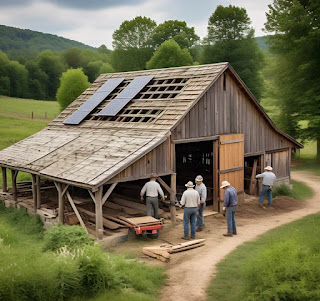Barns are no longer just shelters—they’re productivity machines. In 2025, with rising input costs, animal welfare standards, and climate unpredictability, barn efficiency can make or break a farm. A well-designed barn isn’t just about aesthetics; it’s about optimized labor, energy use, animal flow, and structural longevity.
This blog explores key barn design facts that directly increase efficiency, safety, animal comfort, and long-term profitability—whether you're raising poultry, dairy cows, goats, or managing mixed-use livestock operations.
🏗️ The Hidden Power of Thoughtful Barn Design
A barn that’s poorly laid out often leads to:
- Longer feeding and cleaning times
- Higher injury risk to workers or animals
- Inefficient temperature control
- Disease spread due to poor ventilation
- Maintenance nightmares
But a well-planned barn layout:
- Improves workflow and traffic flow
- Supports animal health and growth
- Minimizes energy and water use
- Enhances biosecurity and disease control
- Allows automation integration
Modern barn design is where architecture meets productivity.
🔁 1. Orientation and Natural Light: Save Energy, Improve Comfort
Positioning a barn to maximize natural light and reduce wind exposure is a free efficiency hack. In most regions, aligning the barn east to west reduces overheating in summer and enhances cross-ventilation.
Large transparent roof panels or polycarbonate sidewalls allow more light in—helping you reduce electricity usage during the day. Natural lighting also supports better laying cycles in poultry and healthier metabolism in ruminants.
💡 Pro tip: Light sensors can adjust internal LED brightness depending on sunlight, further lowering energy costs.
🌬️ 2. Proper Ventilation Layout Reduces Heat Stress and Illness
Good airflow prevents the buildup of:
- Ammonia and methane gases
- Excess humidity (mold, bacterial growth)
- Heat stress in animals, especially poultry and dairy cows
Effective barn ventilation uses a combination of ridge vents, eave inlets, and fans or chimneys. Even passive ventilation, when planned correctly, can create a stack effect that naturally pulls warm air upward.
💨 In 2025, many farms are switching to automated sensor-controlled fans that adjust to real-time humidity and temperature changes—ensuring optimal air quality while saving power.
🐓 3. Efficient Feeding & Watering Systems Cut Labor by 30–50%
A barn with centralized feed alleys or automated feeders and drinkers reduces manual labor dramatically.
For example:
- In poultry barns, nipple drinker systems eliminate spillage
- In dairy barns, TMR mixers and feed pushers reduce feed waste and ensure uniform nutrition
- For goats or sheep, adjustable troughs improve access and cleanliness
Well-positioned feed and water lines also reduce animal aggression and overcrowding.
🛠️ Tip: Elevating feed lines or automating refills also minimizes contamination and rodent infestation.
🧼 4. Waste Management Integration Improves Hygiene and Reduces Costs
Modern barn layouts integrate manure channels, sloped floors, and scraper systems to remove waste efficiently.
Benefits include:
- Lower pathogen buildup
- Reduced ammonia levels
- Easier deep cleaning
- Ability to compost manure onsite or pipe it into a biogas digester
Clean barns mean healthier animals, fewer antibiotics, and better growth rates.
💩 Some advanced designs now include manure belt systems in poultry barns or robotic scrapers in dairy operations that automatically clean aisles multiple times a day.
🚪 5. Animal Flow Efficiency: Reduce Stress, Boost Productivity
Barn layout should support natural animal behavior and movement:
- Straight, wide alleys for easy herding
- Curved gating systems to prevent panic
- No dead-ends where animals might get stuck or turn back
This is especially important in:
- Milking parlors (cows should enter calmly)
- Loading areas for transport
- Broiler or layer house catching zones
Poor flow design leads to stress, bruising, injury, and wasted time.
🐄 Many dairy barns now use free-stall layouts where cows can move and lie down freely, reducing lameness and boosting milk output.
🌡️ 6. Climate Control Enhancements Reduce Death Loss and Energy Use
In extreme climates, barns should be insulated and ventilated strategically. Popular 2025 innovations include:
- Geothermal heating under floors
- Solar-powered fans and misting systems
- Heat recovery units to retain warmth in colder areas
In poultry and pig farms, where temperature fluctuations are deadly, smart thermostats and zoned heating ensure that each area is maintained according to animal age or condition.
🔥 A properly insulated barn can reduce heating needs by up to 40%, especially in cold climates.
🧱 7. Durable Materials Lower Long-Term Maintenance Costs
Steel trusses, rust-resistant coatings, and fire-resistant panels are now preferred materials. While wood may be cheaper upfront, it often:
- Rotates in moist environments
- Harbors pests
- Requires frequent repairs
Durability also applies to flooring—textured concrete or rubber-coated slats resist wear, improve hoof traction, and reduce slips.
📈 Investing in long-lasting materials may cost more initially but pays for itself within 5–7 years through lower repair bills.
🔐 8. Biosecurity Zones: Protect Your Entire Farm System
Good barn design includes separation of clean and dirty areas:
- Entry vestibules for disinfecting boots
- Footbaths and UV lighting
- Clear paths that prevent cross-contamination
You should also design:
- Separate feed storage from manure areas
- Ventilation systems that avoid pulling dirty air into clean zones
- Controlled access for vehicles and workers
🦠 In poultry barns especially, this is non-negotiable to reduce outbreaks like avian influenza.
🧠 Final Thoughts: Smart Barn Design Is a Profitable Investment
Modern barn design is not just a trend—it’s a powerful tool for increasing efficiency, safety, and profit. A thoughtful layout can reduce daily workload, energy consumption, animal mortality, and long-term repair costs.
Efficiency is not about spending the most money—it's about building smarter.
Even small updates—like redirecting airflow, installing automatic drinkers, or changing animal entry points—can yield enormous improvements.
As you expand or renovate your barn in 2025, think not just about today’s needs, but about sustainability, labor savings, and biosecurity for the next decade.

